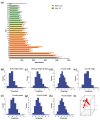Genome-Wide Association Analysis of Growth Traits in Hu Sheep
- PMID: 39766904
- PMCID: PMC11675594
- DOI: 10.3390/genes15121637
Genome-Wide Association Analysis of Growth Traits in Hu Sheep
Abstract
(1) Background: The Hu sheep is a renowned breed characterized by high reproduction, year-round estrus, and resistance to high humidity and temperature conditions. However, the breed exhibits lower growth rates and meat yields, which necessitate improvements through selective breeding. The integration of molecular markers in sheep breeding programs has the potential to enhance growth performance, reduce breeding cycles, and increase meat production. Currently, the applications of SNP chips for genotyping in conjunction with genome-wide association studies (GWAS) have become a prevalent approach for identifying candidate genes associated with economically significant traits in livestock. (2) Methods: To pinpoint candidate genes influencing growth traits in Hu sheep, we recorded the birth weight, weaning weight, and weights at 3, 4, 5, 6, and 7 months for a total of 567 Hu sheep, and genotyping was performed using the Ovine 40K SNP chip. (3) Results: Through GWAS analysis and KEGG pathway enrichment, we identified three candidate genes associated with birth weight (CAMK2B, CACNA2D1, and CACNA1C). Additionally, we found two candidate genes linked to weaning weight (FGF9 and BMPR1B), with CACNA2D1 also serving as a shared gene between birth weight and weaning weight traits. Furthermore, we identified eight candidate genes related to monthly weight (FIGF, WT1, KCNIP4, JAK2, WWP1, PLCL1, GPRIN3, and CCSER1). (4) Conclusion: Our findings revealed a total of 13 candidate genetic markers that can be utilized for molecular marker-assisted selection, aiming to improve meat production in sheep breeding programs.
Keywords: GWAS; Hu sheep; Ovine 40K SNP chip; candidate genes; growth.
Conflict of interest statement
The authors declare no conflicts of interest.
Figures



Similar articles
-
Genome-wide association studies for growth and meat production traits in sheep.PLoS One. 2013 Jun 25;8(6):e66569. doi: 10.1371/journal.pone.0066569. Print 2013. PLoS One. 2013. PMID: 23825544 Free PMC article.
-
Weighted single-step genome-wide association study for direct and maternal genetic effects associated with birth and weaning weights in sheep.Sci Rep. 2024 Jun 7;14(1):13120. doi: 10.1038/s41598-024-63974-0. Sci Rep. 2024. PMID: 38849438 Free PMC article.
-
Identification of Candidate Genes and Functional Pathways Associated with Body Size Traits in Hulunbuir Sheep Through GWAS Analysis.Genes (Basel). 2025 Mar 31;16(4):410. doi: 10.3390/genes16040410. Genes (Basel). 2025. PMID: 40282371 Free PMC article.
-
Design and characterization of a high-resolution multiple-SNP capture array by target sequencing for sheep.J Anim Sci. 2023 Jan 3;101:skac383. doi: 10.1093/jas/skac383. J Anim Sci. 2023. PMID: 36402741 Free PMC article.
-
Advances in genome-wide association studies for important traits in sheep and goats.Yi Chuan. 2017 Jun 20;39(6):491-500. doi: 10.16288/j.yczz.17-021. Yi Chuan. 2017. PMID: 28903908 Review.
Cited by
-
PnNAC03 from Panax notoginseng functions in positively regulating saponins and lignin biosynthesis during cell wall formation.Plant Cell Rep. 2025 Feb 23;44(3):63. doi: 10.1007/s00299-025-03452-7. Plant Cell Rep. 2025. PMID: 39988581
-
A Functional Regulatory Variant of FGF9 Gene Affected the Body Weight in Hu Sheep.Animals (Basel). 2025 Aug 13;15(16):2375. doi: 10.3390/ani15162375. Animals (Basel). 2025. PMID: 40867703 Free PMC article.
-
Genetic Architecture of Hock Joint Bumps in Pigs: Insights from ROH and GWAS Analyses.Animals (Basel). 2025 Apr 20;15(8):1178. doi: 10.3390/ani15081178. Animals (Basel). 2025. PMID: 40282012 Free PMC article.
-
Editorial for the Special Issue "Advances in Cattle, Sheep, and Goats Molecular Genetics and Breeding".Genes (Basel). 2025 Jul 16;16(7):826. doi: 10.3390/genes16070826. Genes (Basel). 2025. PMID: 40725482 Free PMC article.
References
-
- Li X., Yang J., Shen M., Xie X.L., Liu G.J., Xu Y.X., Lv F.H., Yang H., Yang Y.L., Liu C.B., et al. Whole-Genome Resequencing of Wild and Domestic Sheep Identifies Genes Associated with Morphological and Agronomic Traits. Nat. Commun. 2020;11:2815. doi: 10.1038/s41467-020-16485-1. - DOI - PMC - PubMed
-
- Knapik J., Ropka-Molik K., Pieszka M. Genetic and Nutritional Factors Determining the Production and Quality of Sheep Meat—A Review. Ann. Anim. Sci. 2017;17:23–40. doi: 10.1515/aoas-2016-0036. - DOI
-
- Wang X., Wang Y.C., Wang Q.Y., Dai C.P., Li J.Z., Huang P.F., Li Y.L., Ding X.Q., Huang J., Hussain T., et al. The Impact of Early and Mid-Pregnant Hu Ewes’ Dietary Protein and Energy Levels on Growth Performance and Serum Biochemical Indices. J. Appl. Anim. Res. 2023;51:174–181. doi: 10.1080/09712119.2023.2170385. - DOI - PubMed
MeSH terms
LinkOut - more resources
Full Text Sources
Other Literature Sources
Medical
Miscellaneous

